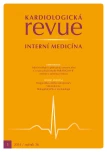Treatment of sideropenic anemia in gastroenterology
Authors:
M. Lukáš
Authors‘ workplace:
Klinické a výzkumné centrum pro střevní záněty ISCARE I. V. F a. s. Ústav lékařské biochemie a laboratorní diagnostiky 1. LF UK
Published in:
Kardiol Rev Int Med 2014, 16(5): 370-373
Category:
Cardiology Review
Overview
Gastrointestinal causes of sideropenic anemia are very common. For this reason, a specialized endoscopic examination is indicated in at least 15% of gastroenterology patients. The leading causes of anemia are drug-induced gastrointestinal ulcers (NSAID gastropathy, NSA enteropathy) and cancer. Less frequent causes include the failure of iron absorption in celiac disease or the effects of massive bleeding in the digestive tract. Patients with inflammatory bowel diseases represent a specific population, and anemia is present in 70% of them. It is usually a combination of sideropenic anemia with anemia resulting from chronic inflammation. Preparations containing iron bound in carbohydrate complexes (carboxymaltose) represent a significant advance in the treatment of intravenous sideropenic anemia. Unlike iron bound to gluconate or dextran, this new intravenous iron substitution is a highly effective and safe treatment modality.
Keywords:
sideropenic anemia – sideropenia – carboxymaltose – ferotherapy
Sources
1. Kaye P, Garsed K, Ragunath K et al. The clinical utility and diagnostic yield of routine gastric biopsies in the investigation of iron deficiency anemie: A case control study. Am J Gastroenterol 2008; 103: 2883– 2889. doi: 10.1111/ j.1572‑ 0241.2008.02121.x.
2. Goddard AF, James MW, McIntyre AS et al. Guidelines for treatment of iron deficiency anaemia. Gut 2011; 60: 1309– 1316. doi: 10.1136/ gut.2010.228874.
3. Bayraktar UD, Bayraktar S. Tretament of iron deficient anemia associated with gastrointestinal tract diseases. World J Gastroenterol 2010; 16: 2720– 2725.
4. Bager P, Dahlerup JF. Randomised clinical trial:oral vs intravenous iron after upper gastrointestinal haemorrhage – a placebo controlled study. Aliment Pharmacol Ther 2014; 39: 176– 187. doi: 10.1111/ apt.12556.
5. Faber K. Achylia gastrica mit anemia. Medizinische Klinik 1909; 5: 1310– 1325.
6. Bátovský M. Súčasný prístup k anémii u pacientov s nešpecifickými črevnými zápalmi. Gastroent Hepatol 2012; 66: 131– 135.
7. Gasche C, Berstad A, Befrits R et al. Guidelines on the diagnosis and management of iron deficiency and anemia in inflammatory bowel diseases. Inflamm Bowel Dis 2007; 13: 1545– 1553.
8. Hrdlička L, Kohout P, Liberda M et al. Doporučený postup pro diagnostiku a léčbu anemie u IBD. Gastroent Hepatol 2012; 66: 280– 285.
9. Evstatiev R, Marteau P, Iqbal T et al. FERGIcor, a randomized controlled trial on ferric carboxymaltose for iron deficiency anemia in inflammatory bowel disease. Gastroenterology 2011; 141: 846– 853.e1– 2. doi: 10.1053/ j.gastro.2011.06.005.
Labels
Paediatric cardiology Internal medicine Cardiac surgery CardiologyArticle was published in
Cardiology Review

2014 Issue 5
Most read in this issue
- Treatment of anemia and iron deficiency from the hematologist’s perspective
- Antiphospholipid syndrome – diagnostics, manifestation and treatment
- Adverse effects of biological therapy in rheumatology
- Systemic sclerosis
